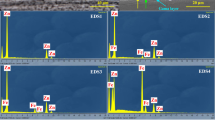Abstract
Corrosion behavior of copper/aluminum was investigated using cyclic wet/dry corrosion test in natural seawater by electrochemical impedance spectroscopy (EIS) and scanning electrochemical microscopy (SECM). The higher charge transfer resistance (Rct) and film resistance (Rf) at 15 d of w/d cyclic corrosion test were shown by EIS plots. The anodic surface releases Al3+ and Cu+ ions into the electrolyte, and the cathodic surface consumes dissolved oxygen. These ions and dissolved oxygen are detected by applying appropriate tip potential in SECM technique. The results showed that the corrosion activity of aluminum was accelerated due to the potential difference of the sample. The scanning electron microscopy with energy-dispersive X-ray spectroscopy (SEM/EDX) analysis showed the enrichment of Cu and Al in corrosion products at the surface of Cu/Al sample after electrochemical analysis. The focused ion beam/transmission electron microscopy (FIB-TEM) analysis confirmed the presence of the nanoscale oxide layers containing Cu and Al in the corrosion product of the Cu/Al sample. The formation of corrosion products has a beneficial effect on corrosion resistance of Cu/Al sample.











Similar content being viewed by others
References
S.T. Elola, T.F. Otero, A. Porro, Evolution of the pitting of aluminum exposed to the atmosphere. Corrosion 48, 854–864 (1992)
J. Damborenea, A. Conde, Comparison of accelerated and atmospheric exposure tests for corrosion’ of aluminium alloys. Br. Corros. J. 30, 292–296 (1995)
R. Vera, D. Delgado, B. Rosales, Effect of unusually elevated SO2 atmospheric content on the corrosion of high power electrical conductors—Part 3. Pure copper. Corros. Sci. 50, 1080–1098 (2008)
M. Arca, M.V. Mirkin, A.J. Bard, Polymer films on electrodes. 26. Study of ion transport and electron transfer at polypyrrole films by scanning electrochemical microscopy. J. Phys. Chem. 99, 5040–5050 (1995)
A.M. Simoes, A.C. Bastos, M.G. Ferreira, Y. González-García, S. Gonzalez, R.M. Souto, Use of SVET and SECM to study the galvanic corrosion of an iron–zinc cell. Corros. Sci. 49, 726–739 (2007)
A.C. Bastos, A.M. Simoes, S. Gonzalez, Y. González-García, R.M. Souto, Application of the scanning electrochemical microscope to the examination of organic coatings on metallic substrates. Prog. Org. Coat 53, 177–182 (2005)
R.M. Souto, Y. González-García, S. González, Evaluation of the corrosion performance of coil-coated steel sheet as studied by scanning electrochemical microscopy. Corros. Sci. 50, 1637–1643 (2008)
R.M. Souto, Y. González-García, J. Izquierdo, S. Gonzalez, Examination of organic coatings on metallic substrates by scanning electrochemical microscopy in feedback mode: Revealing the early stages of coating breakdown in corrosive environments. Corros. Sci. 52, 748–753 (2010)
X. JosephRaj, N. Rajendran, Application of EIS and SECM studies for investigation of anticorrosion properties of epoxy coatings containing ZrO2 nanoparticles on mild steel in 3.5% NaCl solution. J. Fail. Anal. Preven. 16, 1082–1091 (2016)
A.C. Bastos, A.M. Simoes, S. Gonzalez, R.M. Souto, Imaging concentration profiles of redox-active species in open-circuit corrosion processes with the scanning electrochemical microscope. Electrochem. Commun. 6, 1212–1215 (2004)
T.E. Lister, J.P. Patrick, The effect of localized electric fields on the detection of dissolved sulfur species from Type 304 stainless steel using scanning electrochemical microscopy. Electrochim. Acta. 48, 2371–2378 (2003)
E. Kathrin, E. Mathieu, S. Albert, S. Wolfgang, Constant-distance mode AC-SECM for the visualisation of corrosion pits. Electrochem. Commun. 9, 1793–1797 (2007)
E. Tada, S. Satoh, H. Kaneko, The spatial distribution of Zn2+ during galvanic corrosion of a Zn/steel couple. Electrochim. Acta. 49, 2279–2285 (2004)
Acknowledgments
The authors thank Prof. Dr. A. Abudhahir, Prof. P. Sarasu and the Management of Vel Tech Rangarajan Dr. Sagunthala R&D Institute of Science and Technology, Avadi, Chennai-600 062, Tamil Nadu, India, for their constant encouragement and constructive suggestions regarding this research.
Author information
Authors and Affiliations
Corresponding author
Additional information
Publisher's Note
Springer Nature remains neutral with regard to jurisdictional claims in published maps and institutional affiliations.
Rights and permissions
About this article
Cite this article
Joseph Raj, X., Rajendran, N. Investigation into the Corrosion Behavior of Copper/Aluminum Associated with Electric/Electronic Devices in Marine Environment. J Fail. Anal. and Preven. 19, 250–257 (2019). https://doi.org/10.1007/s11668-019-00596-z
Received:
Revised:
Published:
Issue Date:
DOI: https://doi.org/10.1007/s11668-019-00596-z




